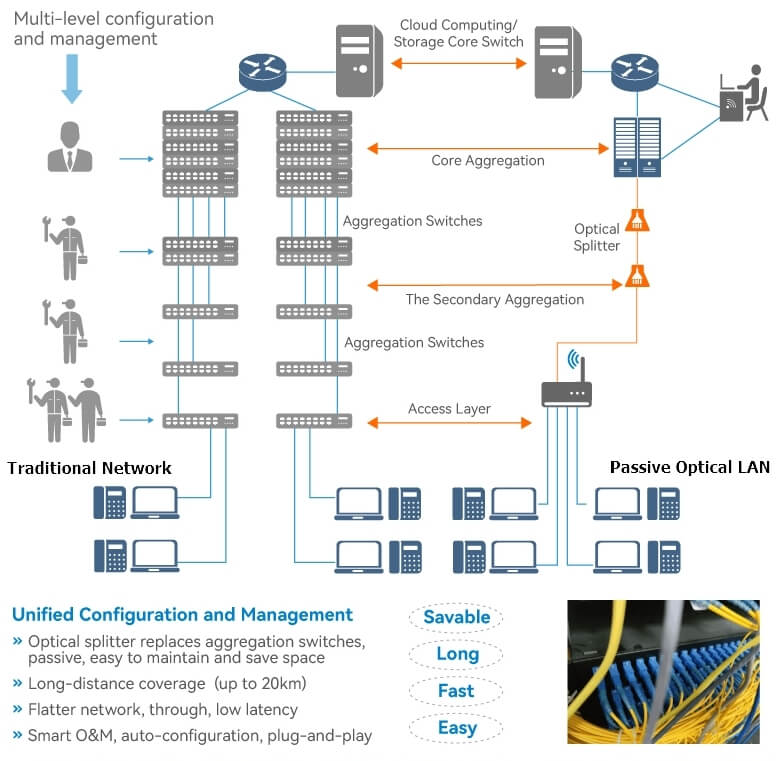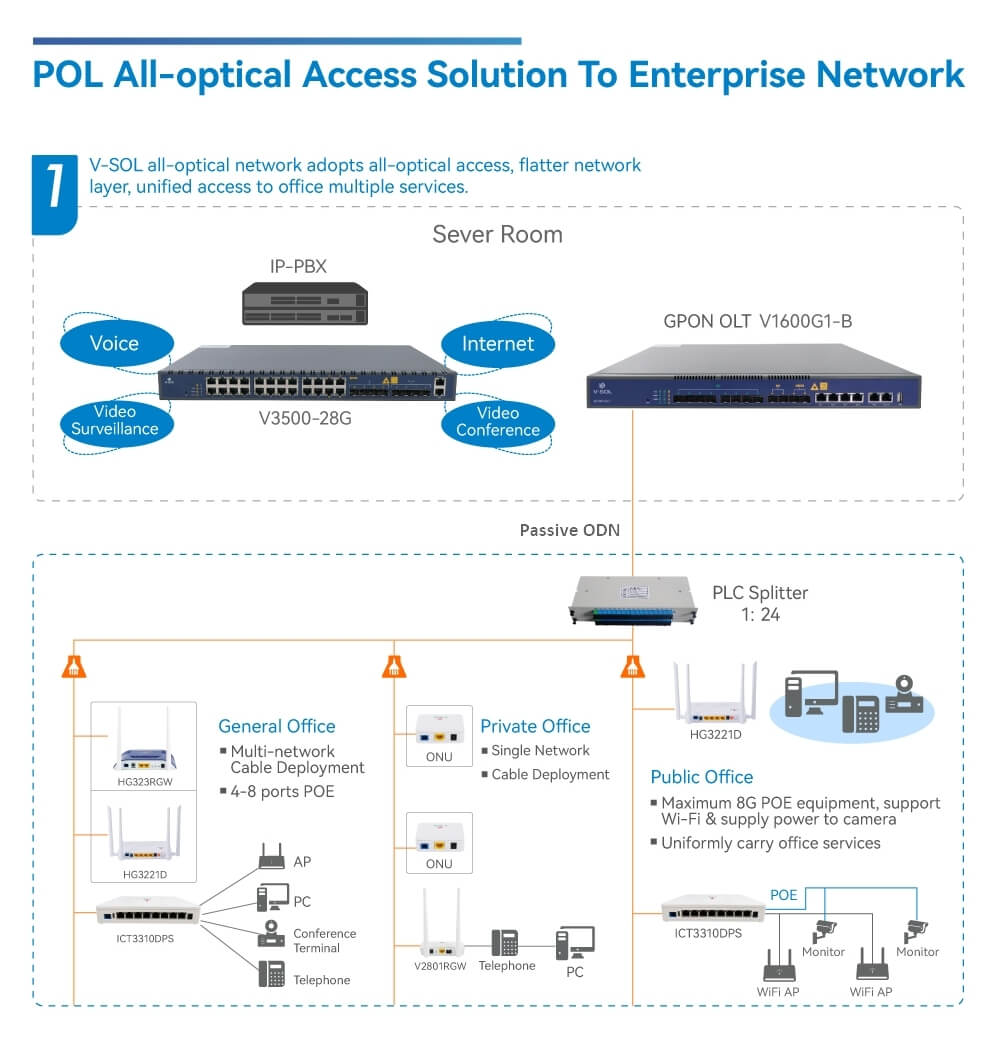Overview of Passive Optical Networks (POL): Benefits and Solution
Overview of Passive Optical Networks (POL): Benefits and Solution
The EPON OLT is a device serving as the endpoint for the service provider in a passive optical network. In other words, the Optical Line Terminal (OLT) manages the Ethernet Passive Optical Network (EPON). This technology offers multiple services thanks to its point-to-multipoint passive optical transmission.
1. What is a passive optical local area network (POL)?
POL stands for Passive Optical Local Area Network (LAN). It is a new PON-based local network solution, leveraging fiber optics and P2MP, to deliver all services with easy deployment and operation. Like all PON systems, POL is a point-to-multipoint system, which transmits data from one point to multiple terminals using an optical splitter. Additionally, it achieves upstream and downstream communications with the WDM.
Advantages of Passive Optical LAN:
1. Deployment of long distance networks
PON consists almost exclusively of single-mode optical fibers that can span 20 km or more. The distance depends on the PON devices and splitter rates. This is an advantage for deploying networks in multi-story buildings and campus networks, although not all networks need to be over such a long distance.
2. Simplify moving, adding and editing the network
Unlike the multi-level tree/star topology adopted by the switch, POL uses the hub-spoke structure, which makes the network flatter and simpler. Therefore, it is easier to add or modify the network.
3. Improve security
POL presents problems such as interruption and leakage of electromagnets. It supports AE128 encryption, ensuring the security of data transmission. In addition, POL equipment supports MAC binding, 802.1x recognition, anti-DOS attack, etc., which can prevent illegal user access and attack.
4. Savings and energy efficiency
On the one hand, the rapid development of terminals increases bandwidth utilization. The traditional cabling network must be rebuilt. However, POL is capable of scaling with the bandwidth and throughput of G PON, 10G PON, 50G PON, etc.
On the other hand, old equipment is abandoned during device iteration, which leads to significant waste. But PON based on optical fiber networks can meet all broadband demands. For example, high bandwidth upstream 10G PON or 50G PON solution can carry the demand of popular WiFi 6 services for 2,5Gbps or 10Gpbs interface. In general, PON is cost-effective and energy-efficient.

2. ELFCAM Passive optical LAN solution for enterprise networks
With the development of IoT and 5G, passive optical local network occupies the market. It has become the best choice for education, government, transportation, enterprise with impressive features such as multiple services, environment, efficiency, security, etc. ELFCAM provides an all-optical POL access solution to the enterprise network.
Like the PON network, POL is composed of OLT, ODN and ONU. Here we take examples with ELFCAM PON devices.
1. In the frame below, V3500-28G switch and V1600G1-B GPON OLT are installed in the server room. The downlink of the OLT connects to the PLC splitter. The dispatcher connects to the different ONUs deployed in the different offices.
2. In the general office, multiple cables can be deployed to set up different networks. In this case, the ELFCAM HG323RGW, HG3221D, and ICT3310DPS ONUs would be an excellent choice to deploy here for multi-wiring network connections.
Notes:
● ONU HG323RGW: The ONU device supports dual modes, including GPON and EPON. It has 2 LAN ports. It complies with the IEEE802.11b/g/n standard.
● ONU HG3221D: There are 4 Gigabit LAN ports, 1 Gigabit WAN port, 1 12V DC power port and a USEB 3.0 port for storage and printer. This is a dual-band ONU router with MTK WiFi 5 chipset, supporting IPV4 and IPV6. The speed can reach up to 1,2Gbps (866Mbps on the 5GHz band and 300Mbps on the 2,4GHz band).
● ICT3310DPS: ICT is a broadband access device that can provide multiple integrated services to users. ICT can provide POE over cables for wireless APs and VoIP.

3. In the private office, each desk was installed with each cable separately. Here we can apply ELFCAM V2801SG and V2801RGW.
Remarks:
● ONU V2801SG: There is only one E/GPON port and one LAN port.
● ONU V2801RGW: it is the same as the previous one but it takes WiFi antennas. It complies with IEEE802.11b/g/c standard and its speed can reach 300Mbps. It can be used to connect the phone and the PC.
4. For public offices, we can also use ONU HG3221D to connect to Internet and ICT for some office services. For example, it provides WiFi and powers the surveillance camera.
Passive optical network (PON) is increasingly used in smart buildings, commercial complexes, residential communities, smart industrial parks, etc. PON products are also increasingly used in different solutions. This is a great combination in the era of IoT and 5G!










